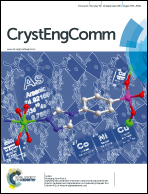Structure versatility of coordination polymers constructed from a semirigid ligand and polynuclear metal clusters†
Abstract
Five new coordination polymers, namely [Cd3(dcppa)(Hdcppa)(H2O)]·(Me2NH2)·(DMA)2 (1), [CdCa(dcppa)(DMA)2] (2), [CdCa(dcppa)(H2O)2(DMA)] (3), [Ba2(H2dcppa)2(μ2-H2O)(H2O)(DMA)]·(H2O) (4), and [Ba2(H2dcppa)2(μ2-H2O)(H2O)(DMF)]·(H2O) (5) (Me2NH2+ = dimethylammonium cation; DMA = N,N-dimethylacetamide; DMF = N,N-dimethylformamide; H4dcppa = 3-(3′,5′-dicarboxylphenoxy) phthalic acid), were synthesized under solvothermal conditions and structurally characterized. Compound 1 presents a unique binodal (3,6)-connected {43}2{47·88} topology structure, which is a 2D layer anionic network with Me2NH2+ cations occupying the voids, built upon a trinuclear Cd3 unit. Compounds 2 and 3 are all bimetallic Cd–Ca compounds consisting of tetranuclear Cd2Ca2 units extending to a 3D (3,6)-connected rtl topology structure and a 2D (3,6)-connected kgd topology structure, respectively. Compounds 4 and 5 are isostructural and exhibit an unprecedented 3D (4,10)-connected topology structure in which a 1D infinite barium chain is observed. From the viewpoint of crystal structure diversity and comparison, our results further demonstrate that the coordination modes of metal ions and ligands are the vital elements in forming the final crystal structure. In addition, the thermal stabilities and solid-state luminescence properties of compounds 1–5 are also discussed.


 Please wait while we load your content...
Please wait while we load your content...